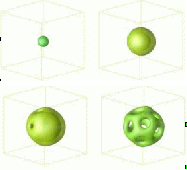 Melts of one or more kinds of polymers exhibit a wealth of diverse phases whose geometric properties make them interesting systems not only for condensed matter research, but for industrial applications, as well. Specifically, block copolymers made of chemically incompatible monomers (say, A and B) exhibit microphase separation, thus forming regular nanoscale patterns of varying complexity. In solvent, they self-assemble to nanoparticles or vesicles which can be used, e.g., as nanocontainers. Melts of one or more kinds of polymers exhibit a wealth of diverse phases whose geometric properties make them interesting systems not only for condensed matter research, but for industrial applications, as well. Specifically, block copolymers made of chemically incompatible monomers (say, A and B) exhibit microphase separation, thus forming regular nanoscale patterns of varying complexity. In solvent, they self-assemble to nanoparticles or vesicles which can be used, e.g., as nanocontainers.
Among other, we study the influence of curvature on structure formation and pattern orientation in thin films and membranes, and we are interested in the effect of crosslinking for the stabilization of ordered structures. Furthermore, we use dynamic self-consistent field theory to study the kinetics of structure formation, e.g., in solutions containing amphiphilic block copolymers.
Another important application for polymers is to attach them to surfaces, thus modifying the surface properties. We are interested in the effect of polydispersity on the structure of such ''polymer brushes'', and on strategies to design smart surfaces that can be used as sensors and switches. For more information, please contact Friederike Schmid .
|

